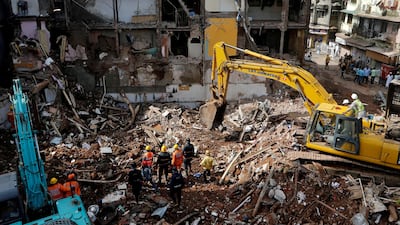The death toll from a building collapse in India's commercial capital Mumbai jumped to 33 on Friday as activists decried the latest deadly housing tragedy to strike the crowded metropolis.
Rescuers pulled more than a dozen bodies from the rubble overnight and were still picking through debris on Friday morning in the hope of finding survivors more than 24 hours after the disaster.
Officials said 22 men, eight women and three children died when the residential building gave way on Thursday morning in the densely populated area of Bhendi Bazaar following heavy rains.
The 117-year-old building had been declared unsafe and was to be demolished as part of a redevelopment project that is transforming Bhendi Bazaar, a shabby colonial-era market that is one of Mumbai's most historic districts.
"Overnight we pulled out 15 bodies, taking the total death count to 33," said Tanaji Kamble, a disaster management spokesman for Mumbai's civic authority.
The dead included a 12-year-old boy and two girls aged 11 and 14, and 12 other people were being treated for injuries at a local hospital, Mr Kamble said.
The collapse was the most recent deadly housing disaster to hit the city, highlighting poor construction standards and ageing buildings in India.
It followed severe rains that have wreaked havoc in many parts of South Asia.
Building collapses are common in Mumbai, especially during the monsoon season from late June to September, when heavy rains lash the western Indian city, weakening poorly built structures.
Millions are forced to live in cramped, dilapidated properties because of spiralling real estate prices and a lack of housing for the poor.
Activists say housing societies, private owners and builders often cut corners to save on costs.
Rent control acts also sometimes mean that landlords cannot afford to maintain buildings, while poor people choose to remain in homes that have been declared unsafe because they have nowhere else to go.
"Builders who take on big projects sometimes don't have the financial capability to deliver nor the expertise, so residents prefer to stay put instead of moving out, which is extremely dangerous," said Krishnaraj Rao, who has campaigned for residents' rights for decades.
"Another reason they remain in haphazard conditions is because they would have to bear the high living cost of staying elsewhere.
"The only practical way to save lives is to use the police to forcibly evict people who are then adequately compensated. Otherwise we are in a precarious situation," he said.
Seventeen people including a three-month-old baby died in July when a four-storey building gave way in the northern suburb of Ghatkopar.
In 2013, 60 people were killed when a residential block came crashing down in one of Mumbai's worst housing disasters.
Thursday's collapse came days after flooding in the city that killed 10 people.
More than 1,200 have been killed India, Nepal and Bangladesh in devastating floods this monsoon season.

